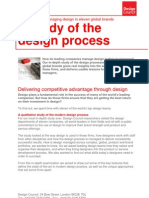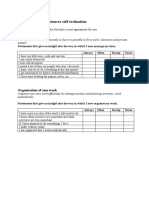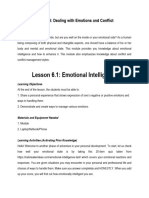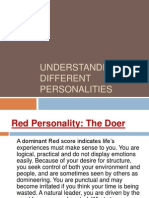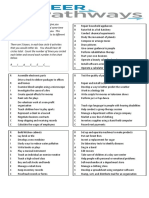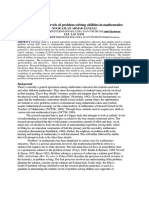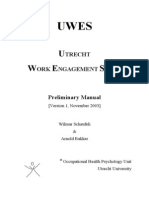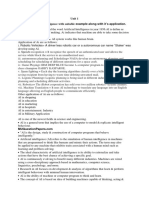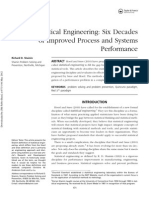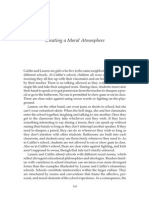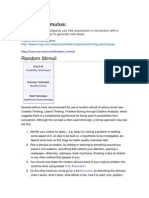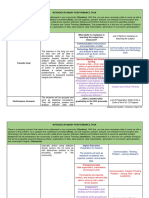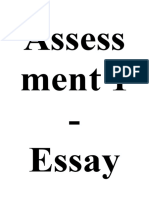ETC Webinar Communication Styles Assessment
ETC Webinar Communication Styles Assessment
Uploaded by
Corina IcaCopyright:
Available Formats
ETC Webinar Communication Styles Assessment
ETC Webinar Communication Styles Assessment
Uploaded by
Corina IcaOriginal Description:
Copyright
Available Formats
Share this document
Did you find this document useful?
Is this content inappropriate?
Copyright:
Available Formats
ETC Webinar Communication Styles Assessment
ETC Webinar Communication Styles Assessment
Uploaded by
Corina IcaCopyright:
Available Formats
Communication: A Self-Assessment Exercise
Below are 40 pairs of sentences. Please select from each pair of attributes the one which is most typical
of your personality. No pair is an either-or proposal. Make your choice as spontaneously as possible.
There is no wrong answer. Circle the number of your choice.
1. I like action.
2. I deal with problems in a systematic way.
3. I believe that teams are more effective than individuals.
4. I enjoy innovation very much.
5. I am more interested in the future than in the past.
6. I enjoy working with people.
7. I like to attend well organized group meetings.
8. Deadlines are important for me.
9. I cannot stand procrastination.
1O. I believe that new ideas have to be tested before being used.
11. I enjoy the stimulation of interaction with others.
12. I am always looking for new possibilities.
13. I want to set up my own objectives.
14. When I start something I go through until the end.
15. I basically try to understand other people's emotions.
16. I do challenge people around me.
17. I look forward to receiving feedback on my performance.
18. I find the step-by-step approach very effective.
19. I think I am good at reading people.
20. I like creative problem solving.
21. I extrapolate and project all the time.
22. I am sensitive to others' needs.
23. Planning is the key to success.
24. I become impatient with long deliberations.
25. I am cool under pressure.
26. I value experience very much.
27. I listen to people.
28. People say that I am a fast thinker.
29. Cooperation is a key word for me.
30. I use logical methods to test alternatives.
31. I like to handle several projects at the same time
32. I always question myself.
33. I learn by doing.
34. I believe that my head rules my heart.
35. I can predict how others may react to a certain action.
36. I do not like details.
37. Analysis should always precede action.
38. I am able to assess the climate of a group.
39. I have a tendency to start things and not finish them up.
40. I perceive myself as decisive.
41. I search for challenging tasks.
42. I rely on observation and data.
43. I can express my feelings openly.
44. I like to design new projects.
Casse, Pierre Training for the Cross-cultural Mind. SIETAR 1981 .Used by permission from Manitoba
Mediation Services Trainers.
Page 1
45. I enjoy reading very much.
46. I perceive myself as a facilitator.
63. I like to get things done.
64. Good relationships are essential.
47. I like to focus on one issue at a time.
48. I like to achieve.
65. I am impulsive.
66. I accept differences in people.
49. I enjoy learning about others.
50. I like variety.
67. Communicating with people is an end in itself.
68. I like to be intellectually stimulated.
51. Facts speak for themselves.
52. I use my imagination as much as possible.
69. I like to organize.
70. I usually jump from one task to another.
53. I am impatient with long, slow assignments.
54. My mind never stops working.
71. Talking and working with people is a creative act.
72. Self-actualization is a key word for me.
55. Key decisions have to be made in a cautious way.
56. I strongly believe that people need each other to get
work done.
73. I enjoy playing with ideas.
74. I dislike wasting my time.
57. I usually make decisions without thinking too much.
58. Emotions create problems.
59. I like to be liked by others.
60. I can put two and two together very quickly.
61. I try out my new ideas on people.
62. I believe in the scientific approach.
75. I enjoy doing what I am good at.
76. I learn by interacting with others.
77. I find abstractions interesting and enjoyable.
78. I am patient with details.
79. I like brief, to the point statements.
80. I feel confident in myself.
Casse, Pierre Training for the Cross-cultural Mind. SIETAR 1981 .Used by permission from Manitoba Mediation
Services Trainers.
Page 2
Scoring Your Communication Style Inventory
Each selected item has to be reported on the four scales reproduced below. In other words, if items 1, 4, 6,
have been selected, the same numbers on the four scales should be circled again. Transfer your selections from
the previous pages to this sheet by circling the sentence number that you selected.
On each style line add up the number of items that you have circled (not the figures but the number of selected
items). The maximum is 20 per style and the total for the four styles should be 40.
1-8-9-13-17-24-26-31-33-40-41-48-50-53-57-63-65-70-74-79 = __3__
Ex. Style 1=
Style 1=
ACTION = 1-8-9-13-17-24-26-31-33-40-41-48-50-53-57-63-65-70-74-79 = _____
Style 2 = PROCESS = 2-7-10-14-18-23-25-30-34-37-42-47-51-55-58-62-66-69-75-78 = _____
Style 3= PEOPLE = 3-6-11-15-19-22-27-29-35-38-43-46-49-56-59-64-67-71-76-80 = _____
Style 4 = IDEA = 4-5-12-16-20-21-28-32-36-39-44-45-52-54-60-61-68-72-73-77 = _____
TOTAL: ______
Styles/Features
Action (A)
Process (PR)
People (PE)
Idea (I)
They talk about
Results * Responsibility
Objectives * Feedback * Performance *
Experience * Productivity * Challenge *
Efficiency * Achievements * Moving
Ahead * Change * Decisions
Facts * Trying Out * Procedures *
Analysis * Planning * Observations *
Organizing * Proof * Controlling * Details
* Testing
People * Self-development * Needs *
Sensitivity * Motivations * Awareness *
Teamwork * Cooperation *
Communications * Beliefs * Feelings *
Values * Team Spirit * Expectations *
Understanding * Relations
Concepts * Whats new in the field *
Innovation * Creativity * Interdependence
* Opportunities * New ways * Possibilities
* New methods * Grand designs *
Improving * Issues * Problems * Potential
* Alternatives
They are
Pragmatic * Direct * Impatient * Decisive * Quick
(jumping from one thing to another) * Energetic *
Challenge Others
Systematic * Logical * Factual * Verbose *
Unemotional * Cautious * Patient
Spontaneous * Empathetic * Warm * Subjective *
Emotional * Perceptive * Sensitive
Imaginative * Charismatic * Difficult to understand *
Ego-centered * Unrealistic * Creative * Full of ideas *
Provocative
Casse, Pierre Training for the Cross-cultural Mind. SIETAR 1981 .Used by permission from Manitoba
Mediation Services Trainers.
Page 3
Plotting Your Results
For a visual overview of your preferred communication style, plot your score from each of the 4 style types on
the appropriate line in the graph above. When you have all four scores plotted you can connect the dots. The
resulting figure will tell you whether you have a strong preference for one communication style or whether the
results are more mixed across 2, 3 or all 4 styles.
ACTION
20
10
IDEA
20
10
10
20
PROCESS
10
20
PEOPLE
Casse, Pierre Training for the Cross-cultural Mind. SIETAR 1981 .Used by permission from Manitoba
Mediation Services Trainers.
Page 4
Coping With Other Communication Styles
A.
Communicating with an action oriented person:
* Focus on the results first (state the conclusion right at the outset).
* State your best recommendation (do not offer many alternatives).
* Be as brief as possible.
* Emphasize the practicality of your ideas.
* Use visual aids.
B.
Communicating with a process oriented person:
Be precise (state the facts).
Organize your presentation in a logical order;
a) background b) present situation c) outcome .
Breakdown your recommendations.
Include options (consider alternatives) with pros and cons.
Do not rush a process oriented person .
Outline your proposal (1,2,3... )
C.
Communicating with a people oriented person:
Allow for small talk (Do not start the discussion right away).
Stress the relationships between your proposal and the people concerned .
Show how the idea worked well in the past.
Indicate support from well respected people.
Use an informal writing style.
D.
Communicating with an idea oriented person:
Allow enough time for discussion.
Do not get impatient when he or she goes off on tangents.
In your opening, try to relate the discussed topic to a broader concept or idea (in other words be
conceptual).
Stress the uniqueness of the idea or topic at hand. Emphasize future value or relate the impact of the idea
or the future
If writing to an idea oriented person, try to stress the key concepts which underlie your proposal or
recommendation right at the outset. Start off with an overall statement and work toward the more
particular.
Casse, Pierre Training for the Cross-cultural Mind. SIETAR 1981 .Used by permission from Manitoba
Mediation Services Trainers.
Page 5
You might also like
- Hypnotherapy Stress Buster ScriptDocument4 pagesHypnotherapy Stress Buster ScriptVijay Kumar100% (3)
- Big 5 Personality Test PDFDocument7 pagesBig 5 Personality Test PDFYeoh SiewchinNo ratings yet
- Indigo AssessmentDocument10 pagesIndigo Assessmentapi-675784992No ratings yet
- Fox Lion and ST BernardDocument19 pagesFox Lion and ST BernardDhani DPNo ratings yet
- 3D Paper StructureDocument6 pages3D Paper StructureCorina IcaNo ratings yet
- 31 - Interpersonal SavvyDocument4 pages31 - Interpersonal SavvyMicu Zambrotta DanielNo ratings yet
- Career Values Assessment Printed TestDocument4 pagesCareer Values Assessment Printed TestEvaAskepidouNo ratings yet
- PA Personality InventoryDocument11 pagesPA Personality InventoryFany Tiara IndahNo ratings yet
- DiscselfsamplereportDocument38 pagesDiscselfsamplereportapi-280199986No ratings yet
- Bristol Skills FrameworkDocument3 pagesBristol Skills FrameworkLetitia100% (1)
- True Colors Via U of MissouriDocument14 pagesTrue Colors Via U of MissouriugomiesterNo ratings yet
- Peer Relationships enDocument3 pagesPeer Relationships enLeni A100% (1)
- Honey and Mumford Learning Styles QuestionnaireDocument8 pagesHoney and Mumford Learning Styles QuestionnaireRowan0% (1)
- The Rainbow Personality Test 2Document3 pagesThe Rainbow Personality Test 2Cj CaoNo ratings yet
- Reflective Exercise 4 My Self-Assessment With Swot AnalysisDocument11 pagesReflective Exercise 4 My Self-Assessment With Swot Analysisapi-407839349No ratings yet
- Leadership Style AssessmentDocument2 pagesLeadership Style AssessmentmaponlooNo ratings yet
- Communication Styles Handout LeadershipDocument6 pagesCommunication Styles Handout LeadershipBoï-Dinh ONNo ratings yet
- Best Practice in Integrated Talent ManagementDocument30 pagesBest Practice in Integrated Talent ManagementCorina Ica100% (3)
- Mayer & Anderson (1992)Document9 pagesMayer & Anderson (1992)Victoria AlexandrovaNo ratings yet
- Eleven Lessons - Managing Design in Eleven Global BrandsDocument144 pagesEleven Lessons - Managing Design in Eleven Global BrandsDesign Council100% (17)
- The Innovation Algorithm - TRIZ, Systematic Innovation & Technical Creativity (Genrich Altshuller)Document290 pagesThe Innovation Algorithm - TRIZ, Systematic Innovation & Technical Creativity (Genrich Altshuller)YorHa Member100% (2)
- Technical Communication ReportDocument31 pagesTechnical Communication ReportMA CadizNo ratings yet
- Comm Self AssessmentDocument7 pagesComm Self AssessmentKevin CoolNo ratings yet
- Learning Style QuestionnaireDocument3 pagesLearning Style QuestionnairePriti Priya100% (1)
- LS QuestionnaireDocument4 pagesLS QuestionnaireMuhamad IrhamNo ratings yet
- Disc & Motivators Report For: Angelica BerdeguelDocument10 pagesDisc & Motivators Report For: Angelica BerdeguelAngelica AngieNo ratings yet
- Locus of ControlDocument3 pagesLocus of ControlAmisha MehtaNo ratings yet
- Learningstyleinventory SurveyDocument8 pagesLearningstyleinventory Surveyapi-220105036100% (1)
- Psychological Safety QuestionnaireDocument3 pagesPsychological Safety QuestionnaireFarrah MalaNo ratings yet
- Commerce 2ba3 Organizational Behaviour: Class 9 Conflict and Stress Dr. Christa WilkinDocument44 pagesCommerce 2ba3 Organizational Behaviour: Class 9 Conflict and Stress Dr. Christa WilkinakhilNo ratings yet
- Activity BigFivePersonalityTest ABADocument3 pagesActivity BigFivePersonalityTest ABADana MagalonaNo ratings yet
- Risb Scoring ManualDocument2 pagesRisb Scoring ManualTauseef Fatima0% (1)
- Compendium of Questionnaires and Inventories Volume 2Document234 pagesCompendium of Questionnaires and Inventories Volume 2geronimo007No ratings yet
- The Working Life: The Importance of Workplace Mentors: An Time Tested MethodDocument4 pagesThe Working Life: The Importance of Workplace Mentors: An Time Tested MethodmrsundeepsNo ratings yet
- Behavioural Competences Self Evaluation: Time ManagementDocument13 pagesBehavioural Competences Self Evaluation: Time ManagementJoey ScofieldNo ratings yet
- 036 Glavin The Riasec GameDocument7 pages036 Glavin The Riasec Gameirish xNo ratings yet
- MotivationDocument37 pagesMotivationKoushik KumarNo ratings yet
- Personality Assessment - Carreer TestDocument7 pagesPersonality Assessment - Carreer TestboranscribdNo ratings yet
- CSP 621 Growth Mindset Lesson PlanDocument4 pagesCSP 621 Growth Mindset Lesson Planapi-548723359No ratings yet
- DiscDocument3 pagesDiscapi-523050935No ratings yet
- The Riasec Test: My Interest CodeDocument2 pagesThe Riasec Test: My Interest CodeNico PelomianoNo ratings yet
- Self Esteem AssessmentDocument2 pagesSelf Esteem AssessmentswathiNo ratings yet
- Module 6 Lesson 1 Emotional IntelligenceDocument11 pagesModule 6 Lesson 1 Emotional IntelligenceMaricris OcampoNo ratings yet
- Ocial Cience: Best News Yet On The Six-Factor Model of Well-BeingDocument17 pagesOcial Cience: Best News Yet On The Six-Factor Model of Well-BeingJoana MaiaNo ratings yet
- WC - Needs Feelings InventoryDocument3 pagesWC - Needs Feelings InventoryToyin AlatiseNo ratings yet
- Raymond B. Cattell: Factor Analytic Trait TheoryDocument16 pagesRaymond B. Cattell: Factor Analytic Trait Theorykatb100% (1)
- Circle One of The Following Responses For Each StatementDocument4 pagesCircle One of The Following Responses For Each StatementHannah C. EdanganNo ratings yet
- Emotional IntelligenceDocument17 pagesEmotional IntelligencekunchadkaNo ratings yet
- Understanding Different PersonalitiesDocument23 pagesUnderstanding Different Personalitiesmaye321No ratings yet
- Quiz: Are You Ready To Be An Entrepreneur?: Yes NoDocument5 pagesQuiz: Are You Ready To Be An Entrepreneur?: Yes NoAbhishek MohiteNo ratings yet
- Personal Development - Ultimate Guide To Self-Growth (With Cover Page)Document98 pagesPersonal Development - Ultimate Guide To Self-Growth (With Cover Page)samazhrpNo ratings yet
- Career Pathways SurveyDocument2 pagesCareer Pathways SurveyTom Prescott0% (1)
- FIRO-B Interpretive Report For OrganizationsDocument13 pagesFIRO-B Interpretive Report For OrganizationsSandip Kumar RamjiNo ratings yet
- Adhd For CounselorsDocument7 pagesAdhd For CounselorsEdl ZsuzsiNo ratings yet
- Role of Religious Orientation and Mental Health On Critical Thinking Among AcademiciansDocument9 pagesRole of Religious Orientation and Mental Health On Critical Thinking Among AcademiciansGlobal Research and Development ServicesNo ratings yet
- Personality Test: L - B - O - G RDocument2 pagesPersonality Test: L - B - O - G Rapi-509516948No ratings yet
- Problem Solving Ability PDFDocument8 pagesProblem Solving Ability PDFRajakumaran100% (1)
- Energy QuestionnaireDocument4 pagesEnergy QuestionnairegbarcelonNo ratings yet
- TEIQue SFDocument1 pageTEIQue SFchengalpet sai krishnaNo ratings yet
- Developed by DR Dalip Singh & DR NK Chadha: Know Your EQ: Emotional Quotient TestDocument5 pagesDeveloped by DR Dalip Singh & DR NK Chadha: Know Your EQ: Emotional Quotient TestPreeti GoyalNo ratings yet
- Time Management Techniques For NEET Aspirants A Step-By-Step GuideDocument2 pagesTime Management Techniques For NEET Aspirants A Step-By-Step GuidePrepMed InstituteNo ratings yet
- Via PosterDocument1 pageVia PosterAdriana GeorgescuNo ratings yet
- Family Environment Scale: Name and Type of MeasureDocument5 pagesFamily Environment Scale: Name and Type of Measurerodriguescatia306992No ratings yet
- 4 Exploring Your Personality Q and Scoring Key (Transaction Analysis)Document3 pages4 Exploring Your Personality Q and Scoring Key (Transaction Analysis)Tarannum Yogesh DobriyalNo ratings yet
- Hollands CodeDocument27 pagesHollands CodeElisa Maya SelfianaNo ratings yet
- Journal of Substance Abuse Treatment: Lori J. Ducharme, PH.D., Redonna K. Chandler, PH.D., Alex H.S. Harris, PH.DDocument9 pagesJournal of Substance Abuse Treatment: Lori J. Ducharme, PH.D., Redonna K. Chandler, PH.D., Alex H.S. Harris, PH.DCorina IcaNo ratings yet
- Treatment Improvement Protocol (TIP) Series 34: Brief Interventions and Brief Therapies For Substance AbuseDocument292 pagesTreatment Improvement Protocol (TIP) Series 34: Brief Interventions and Brief Therapies For Substance AbuseCorina IcaNo ratings yet
- Sadam ProfilDocument28 pagesSadam ProfilCorina IcaNo ratings yet
- Assessment: The Psychopathy Q-Sort: Construct Validity Evidence in A Nonclinical SampleDocument6 pagesAssessment: The Psychopathy Q-Sort: Construct Validity Evidence in A Nonclinical SampleCorina IcaNo ratings yet
- Healthy PersonalityDocument15 pagesHealthy PersonalityCorina IcaNo ratings yet
- Homicide Studies 2011 Nivette 103 31Document30 pagesHomicide Studies 2011 Nivette 103 31Corina IcaNo ratings yet
- Criminal Justice and Behavior 2013 Mokros 1397 412Document17 pagesCriminal Justice and Behavior 2013 Mokros 1397 412Corina IcaNo ratings yet
- OD Diagnosis: J. Michael Sammanasu JIMDocument34 pagesOD Diagnosis: J. Michael Sammanasu JIMCorina IcaNo ratings yet
- Training Course Factsheet OPQ Level BDocument2 pagesTraining Course Factsheet OPQ Level BCorina IcaNo ratings yet
- Training Course Factsheet Personality and Ability AssessmentDocument2 pagesTraining Course Factsheet Personality and Ability AssessmentCorina IcaNo ratings yet
- Construct ValidityDocument20 pagesConstruct ValidityCorina IcaNo ratings yet
- Utrecht ScaleDocument58 pagesUtrecht ScaleMaya CamarasuNo ratings yet
- Unit 1 Elaborate Artificial Intelligence With Suitable Example Along With It's ApplicationDocument46 pagesUnit 1 Elaborate Artificial Intelligence With Suitable Example Along With It's Applicationfaiyaz pardiwalaNo ratings yet
- Assessment 2 Unit Plan Addition and SubtractionDocument14 pagesAssessment 2 Unit Plan Addition and Subtractionapi-361854774No ratings yet
- Improved Process and Systems PerformanceDocument13 pagesImproved Process and Systems PerformanceAnonymous X0iytQQYJ6No ratings yet
- TEMPLATE eRPHDocument17 pagesTEMPLATE eRPHNUREHAN BT MOHAMAD ZAINAL ABIDIN KPM-GuruNo ratings yet
- Od Practitioners StyleDocument26 pagesOd Practitioners Styleunnu123No ratings yet
- Creating A Moral AtmosphereDocument28 pagesCreating A Moral AtmosphereHay Day RNo ratings yet
- Weerakkody Research GlossaryDocument12 pagesWeerakkody Research GlossarysamarNo ratings yet
- Syllabus Mathematics in The Modern WorldDocument19 pagesSyllabus Mathematics in The Modern WorldJham L. PatraNo ratings yet
- Scooters India LTD ReportDocument105 pagesScooters India LTD ReportVaibhao VermaNo ratings yet
- DL2 Interview QuestionsDocument34 pagesDL2 Interview QuestionsMohammad MudassirNo ratings yet
- 2000 Decentralization Conditions For SuccessDocument146 pages2000 Decentralization Conditions For SuccessAngela StafiiNo ratings yet
- Operating System 3Document7 pagesOperating System 3Rodel Delos ReyesNo ratings yet
- System Development Life Cycle (SDLC)Document28 pagesSystem Development Life Cycle (SDLC)wasiuddin100% (1)
- Idea Generation ToolboxDocument37 pagesIdea Generation ToolboxAlba P. Romero100% (2)
- Music From Dreams in The Compositional Process: An Online SurveyDocument32 pagesMusic From Dreams in The Compositional Process: An Online SurveyKeane SouthardNo ratings yet
- McKinsey Postgrad Careers BrochureDocument8 pagesMcKinsey Postgrad Careers BrochureJumie SamsudinNo ratings yet
- Rhea L. Payot BSED-Math 4 Module 1 Lesson 1 FS2: ActivityDocument18 pagesRhea L. Payot BSED-Math 4 Module 1 Lesson 1 FS2: ActivityJohannah Grace ElviraNo ratings yet
- Part 2.2 Sample Intradisicplinary PT - Docx (1) 2Document3 pagesPart 2.2 Sample Intradisicplinary PT - Docx (1) 2Andremae LorenoNo ratings yet
- Assessing Narrative Competence Seminars PDFDocument15 pagesAssessing Narrative Competence Seminars PDFSwathi G100% (2)
- EMA-Undergrad FallDocument19 pagesEMA-Undergrad FallburntNo ratings yet
- A3 Thinking: Facilitator's GuideDocument4 pagesA3 Thinking: Facilitator's GuideErmanda DishaNo ratings yet
- Manual For Interviewers 2012/13: Admissions Undergraduate Medical Program Michael G. Degroote School of MedicineDocument14 pagesManual For Interviewers 2012/13: Admissions Undergraduate Medical Program Michael G. Degroote School of MedicineAlisonNo ratings yet
- Assess Ment 1 - EssayDocument5 pagesAssess Ment 1 - Essaykajol kristinaNo ratings yet
- FinalDocument6 pagesFinalTarun PNo ratings yet



















